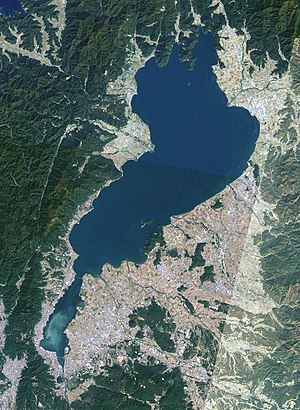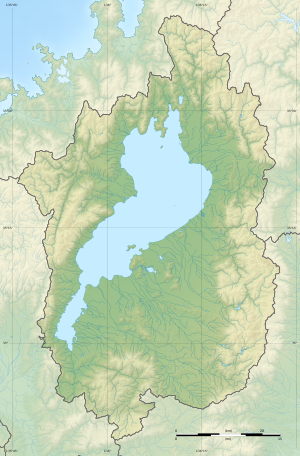Lake Biwa
| Lake Biwa | ||
|---|---|---|

|
||
| Geographical location | Shiga Prefecture , Japan | |
| Tributaries | 118 | |
| Drain | Setagawa | |
| Islands | 3 natural, 1 artificial | |
| Places on the shore | Nagahama , Maibara , Hikone , Higashiōmi , Ōmihachiman , Yasu , Moriyama , Kusatsu , Ōtsu , Takashima (clockwise) | |
| Data | ||
| Coordinates | 35 ° 17 ′ N , 136 ° 7 ′ E | |
|
|
||
| Altitude above sea level | 84.37 m TP | |
| surface | 669.23 km² | |
| length | 63.49 km | |
| width | 22.8 km | |
| volume | 27.5 km³ | |
| scope | 235 km | |
| Maximum depth | 103.58 m | |
| Middle deep | 43 m (North Sea), 4 m (South Sea) | |
The Lake Biwa ( Japanese 琵琶湖 Biwa-ko ) is the largest lake in Japan .
It has an area of 674 km² (compared to Lake Constance : 536 km²) and is completely surrounded by the Shiga prefecture . The lake is narrow in the south (a bridge leads over the narrowest point of 1.35 km and divides the lake into a north and a south part) and elongated (63.49 km). It has its deepest point at 103.58 m in the northwest at the mouth of the Ado River. The mean depth is 43 m in the North Sea and 4 m in the South Sea. Its catchment area is 3,848 km², about 96% of the area of the Shiga Prefecture surrounding it.
Surname
The name Biwa Lake became popular in the Edo period. There are various theories about the origin of the name Biwa Lake, but it is generally believed that its name derives from the similarity of its shape to the Biwa sound. Koso, a learned monk of the Enryaku-ji monastery in the 14th century, writes about the origin of the name Biwa Lake: “The lake is the pure land of the goddess Benzaiten , who lives on the island of Chikubushima , and the shape of the lake resembles that Biwa lute , her favorite instrument. "
The lake used to be known under the name Awaumi ( 淡 海 , "fresh water lake") or Chika tsu Ahaumi ( 近 淡 海 , "near fresh water lake") in contrast to Lake Hamana as a "distant fresh water lake". Later the pronunciation changed from Ahaumi via Afumi to modern Oumi / Ōmi as in the name of the Ōmi province . The lake is in the literature Nio no Umi ( 鳰の海 , "Lake of the dwarf diver called").
geography
The south of the lake is encompassed by the city of Ōtsu and its suburbs; the west bank sloping down from the mountain slopes of the Hiei falls more steeply in the middle. The historically significant areas of the plains around Kusatsu, Yasu, Omihachiman, Hikone, Maibara and Nagahama adjoin the east bank. In the north, the mountain walls sometimes extend directly into the water. Here the water quality is extremely good. The beaches near Makino were listed as one of the 12 most beautiful beaches in Japan by the Ministry of the Environment in 2006 due to their water quality.
There are three natural islands in Lake Biwa: The 1.5 km² island of Okishima ( 沖 1,5 ), which is inhabited by 450 people and belongs to the city of Ōmihachiman , and the excursion destination Chikubushima ( 竹 生 島 , 35 ° 25 ′ N , 136 ° 9 ′ E ) 0 , 14 km² and the very small rock island Takeshima ( 多 景 島 , 35 ° 18 ′ N , 136 ° 11 ′ E ). 1978 began with the filling of the 0.73 km² large island Yabasekihan-tō ( 矢 橋 帰 帆 島 , 35 ° 0 ' N , 135 ° 55' E ), which was completed in 1982. In the middle of the lake are the white cliffs Oki no Shiraishi ( liegen の 白石 ).
Lake Biwa has 118 tributaries, but only one outflow in the south, the Seta-gawa , which flows into Osaka Bay . Significant tributaries clockwise from west to south are: Kamo-gawa ( 鴨 川 ), Ado-gawa ( 安 曇 川 ), Chinai-gawa ( 知 内 川 ), Ane-gawa ( 姉 川 ), Amano-gawa ( 天野 川 ), Inukami-gawa ( 犬 上 川 ), Uso-gawa ( 宇 曽 川 ), Echi-gawa ( 愛 知 川 ), Hino-gawa ( 日 野 川 ), Yasu-gawa ( 野 洲 川 ) and the Kusatsu-gawa ( 草津 川 ).
geology
According to geological research, the lake was formed about 4 million years ago. It is probably the third oldest lake in the world ( long-term lake ), after Lake Baikal and Lake Tanganyika . The lake was created in what is now the neighboring prefecture of Mie and then slowly moved into its current location.
Fish fauna
There are some endemic fish species in Lake Biwa , such as Gnathopogon caerulescens , Gymnogobius isaza and the large Silurus biwaensis .
history
Lake Biwa is in close proximity to the Japanese historical heartland, the Yamato province around the city of Nara and the Yamashiro province around the city of Kyoto . The former name Ōmi of the region around Lake Biwa, referring to Lake Biwa, as it was until the Meiji Restoration , can still be found in many place names today. Emperor Tenji moved the capital briefly to Ōmi-kyō (today: Ōtsu) on Lake Biwa. Until about 1900, shipping across Lake Biwa was an important link in the transport network connecting the two regions of Hokuriku and Kansai .
The Biwasee Canal boosted Kyoto's economy when it was doomed when the emperor moved to Tokyo .
Others
Many temples were built in the romantic landscape on the west bank. The beauty of the landscape and the variety of perspectives have inspired Japanese poets since time immemorial. A list of the “ eight most beautiful views on Lake Biwa ” was drawn up, which is also the basis for the work The eight faces on Lake Biwa by German writer Max Dauthendey from 1911.
A specialty that is little loved even by most Japanese today is a type of sushi, Funazushi , in which the raw freshwater fish are marinated in salt for a period of over 2 years.
The asteroid (4289) Biwako , discovered on October 29, 1989, was named after the lake in 1990.
See also
Web links
- Information ( memento of July 25, 2015 in the Internet Archive ) at MLIT (English)
- Shiga Prefecture Comprehensive Guide (230 pages) to the Lake (Japanese)
- Information from the Lake Biwa Research Institute (Japanese)
Individual evidence
-
↑ a b c d e f g h i j k Biwako - Lake and Rivers. In: 琵琶湖 河川 事務所 . MLIT, archived from the original on February 22, 2013 ; accessed on August 5, 2016. ) の あ ら ま し . In: 琵琶湖 河川 事務所 . MLIT, accessed August 5, 2016 (Japanese).
- ^ Water Management System on Lake Biwa. (PDF; 529 kB) MLIT , archived from the original on November 12, 2013 ; accessed on August 5, 2016 .
- ↑ Gnathopogon caerulescens on Fishbase.org (English)
- ↑ Gymnogobius isaza on Fishbase.org (English)
- ↑ Silurus biwaensis on Fishbase.org (English)
- ↑ Minor Planet Circ. 16248 (PDF)


